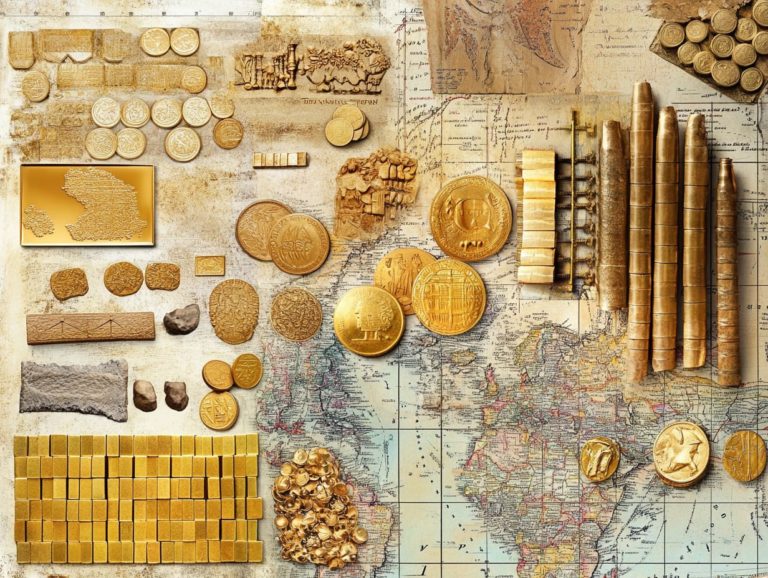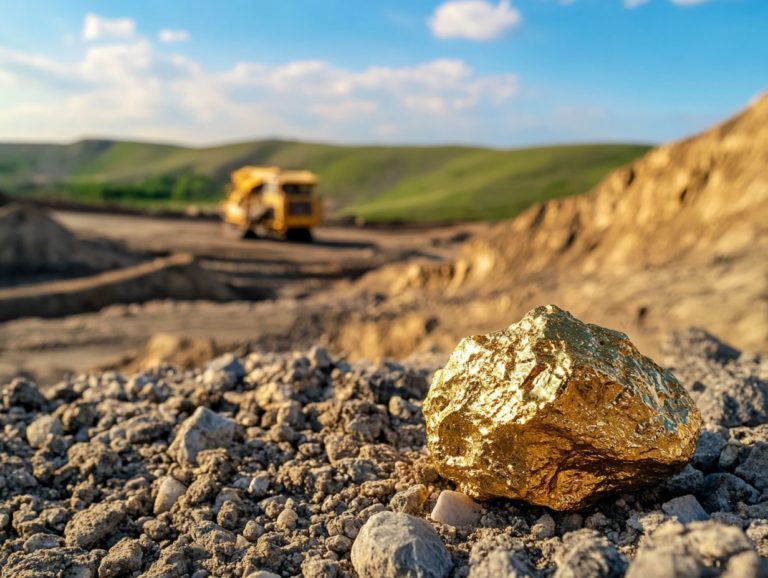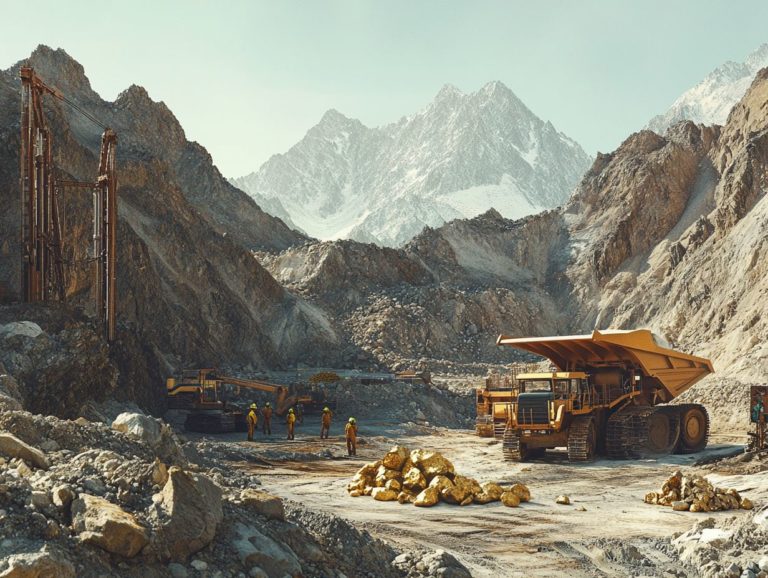What is Platinum Worth?
Platinum is often celebrated as one of the most precious metals, renowned for its rarity and exceptional properties.
What truly makes platinum valuable? This exploration delves into the multifaceted nature of platinum, examining its industrial applications and its undeniable allure in the jewelry market.
You ll discover the factors that influence its worth, along with current and historical price trends, as well as the dynamics of supply and demand.
This guide highlights the benefits and risks of investing in platinum, paired with its future outlook.
Whether you re an astute investor or simply intrigued, get ready to uncover valuable insights into the captivating world of platinum.
Contents
Key Takeaways:
- Platinum is a rare and valuable precious metal with industrial, investment, and jewelry applications.
- The price of platinum is determined by market demand and supply, alongside other factors such as economic conditions.
- Investing in platinum can offer benefits but comes with risks; the future outlook depends on various predictions.
Understanding the Value of Platinum
Understanding the true value of platinum requires a deep dive into its diverse roles within the precious metals market and its various industrial applications. All these factors have a profound impact on its price.
As a precious metal, platinum doesn’t just compete with gold and silver in the investment sphere; it also serves a critical function in the production of catalytic converters and other advanced technologies.
The intricate dynamics of supply and demand, combined with ever-changing market prices, are crucial for you whether you’re a consumer, trader, or dealer to make well-informed decisions when it comes to buying, selling, or trading platinum bullion.
What is Platinum?
Platinum is a rare and precious metal that commands attention for its unique properties and diverse applications, particularly in investment, jewelry, and industrial use.
Renowned for its remarkable resistance to corrosion and high melting point, platinum has been woven into the fabric of various cultural artifacts and ornaments for centuries. It was first discovered in South America, where it initially played second fiddle to gold and silver.
However, over time, its significance soared, especially in the automotive sector, where it serves as a vital catalyst in emissions control devices, thereby enhancing environmental sustainability.
As an investor, you ll find platinum to be a strategic asset that offers valuable diversification in your portfolio, particularly during periods of economic volatility.
Beyond its aesthetic allure in luxury goods, platinum also plays a crucial role in advancing technology and supporting environmental initiatives, making it a multifaceted gem in the world of precious metals.
Factors that Influence Platinum’s Worth
The value of platinum is shaped by a complex interplay of factors, including market demand and supply fluctuations, economic conditions, and trading activities across the globe.
Among these, mining costs stand out, exerting a significant influence on production levels, especially in key mining nations like South Africa and Russia. The operational challenges and stringent environmental regulations in these regions often dictate how much platinum can be extracted.
This directly impacts its availability in the market. Economic indicators, such as inflation rates and industrial growth, play a pivotal role in driving market behavior.
As industries, particularly automotive manufacturing, ramp up their demand for catalytic converters, you may notice notable shifts in the value of this precious metal changes that are further influenced by geopolitical events and broader global economic trends.
Uses of Platinum
Platinum serves an array of essential functions across various sectors, encompassing industrial applications, investment strategies, and exquisite jewelry.
This versatility positions it as a valuable asset within both technological and economic realms.
Industrial Applications
Platinum s industrial applications are remarkably extensive, especially in the manufacturing of catalytic converters (devices that convert exhaust gases into less harmful emissions), which are crucial for reducing harmful emissions in diesel vehicles and various other technologies.
This precious metal converts toxic gases such as carbon monoxide, hydrocarbons, and nitrogen oxides into far less harmful substances like carbon dioxide and nitrogen, thereby promoting cleaner air.
Beyond the automotive realm, platinum is gaining prominence in the electronics sector, where it is employed in crafting high-performance components like connectors and hard disk drives.
Industries that harness hydrogen fuel cells (devices that convert hydrogen into electricity) reap the benefits of platinum’s unique catalytic properties, which significantly boost efficiency and durability.
Its role in green technologies is paramount, establishing platinum as a key player in global efforts to combat climate change and reduce environmental footprints.
Investment and Jewelry
As an investment, platinum often serves as a hedge against economic uncertainty, while its striking aesthetic makes it a sought-after choice for high-end jewelry, leading to fluctuating market demand.
This dual nature of platinum distinguishes it in the world of precious metals. Unlike gold, which has long been viewed as the safe haven, platinum’s rarity and unique characteristics attract a specific clientele. The shifting demand in the automotive industry, especially for catalytic converters, further enhances its appeal as an investment.
Recent trends reveal a growing appreciation for platinum in luxury markets, with consumers increasingly captivated by its durability and radiant luster. When you explore platinum, you balance its investment potential with its appeal in fine jewelry, weaving a rich tapestry of market dynamics.
Determining the Price of Platinum
Determining the price of platinum requires you to engage in a thorough analysis of market demand and supply dynamics (the overall availability of platinum in the market). You’ll also need to consider the various trading influences that can lead to fluctuations in its value.
Market Demand and Supply
The interplay of market demand and supply has a significant impact on platinum pricing, with shifts in either side leading to notable fluctuations in its market value.
Several factors contribute to these shifts, including variations in industrial demand, evolving consumer preferences, and overarching economic conditions. For instance, when the automotive industry moves towards cleaner technologies, the demand for catalytic converters may decrease, subsequently reducing overall demand. Conversely, if consumers gravitate towards luxury items like platinum jewelry, you might see demand surge, driving prices higher.
Economic downturns also play a critical role; during recessionary phases, both consumer and industrial spending typically decline, further complicating the delicate balance of platinum’s supply and demand landscape.
Other Influencing Factors
Beyond the basic principles of supply and demand, several economic factors such as mining costs, geopolitical stability, and trading behavior play integral roles in shaping platinum’s price.
The mining operations, especially in South Africa and Russia, significantly influence the metal’s availability and pricing. As the largest producer, South Africa’s output is particularly vulnerable to disruptions like labor strikes or political unrest, which can lead to shortages and consequently drive prices up.
Technological advancements in extraction methods and recycling practices can enhance mining efficiency and help stabilize supply. Additionally, macroeconomic trends such as inflation rates, currency fluctuations, and overall global economic health shape investor sentiment and trading behaviors, further affecting platinum prices.
As industries push the envelope with innovative applications for platinum especially in the realm of clean energy technologies the demand dynamics shift. This creates a complex web of variables that you must carefully consider as an investor.
Curious about how platinum can enhance your investment strategy? Act now to invest in platinum!
Current and Historical Prices of Platinum
Analyzing the current and historical prices of platinum unveils the trends and fluctuations that define its market performance over time. This exploration provides valuable insights for both investors and traders, helping them navigate the complexities of the platinum market with greater confidence.
Trends and Fluctuations
Examining the trends and fluctuations in platinum prices offers valuable insights into market behavior and the factors that drive its value.
This precious metal has seen significant price swings over the years, influenced by many factors such as supply and demand dynamics, economic conditions, and geopolitical events. Shifts in global automotive production, especially regarding pollution control systems, play a crucial role in platinum’s demand. Mining disruptions and changes in export regulations in key producing countries can also lead to sudden price changes.
Recent trends suggest that more investors are looking toward platinum as a viable investment option amid rising inflation. This prompts market participants like you to reassess the long-term potential of this metal compared to gold and silver.
Investing in Platinum
Investing in platinum offers exciting benefits but also important risks to consider. You should carefully weigh these against current market conditions and your personal investment objectives.
It’s essential to consider how platinum aligns with your overall strategy and financial aspirations.
Benefits and Risks
Investing in platinum offers a range of benefits, including its rarity, potential for appreciation, and unique industrial applications. Be aware of the risks, such as changes in the market and fluctuating demand.
Beyond its scarcity, platinum often outshines other precious metals, particularly in industries like automotive, where it plays a vital role in catalytic converters, which reduce harmful emissions from vehicles. This demand can significantly influence its market performance, especially in response to shifts in global economic trends.
As a potential investor, exercise caution. The price of platinum can experience sudden fluctuations driven by economic downturns or changing industrial requirements. While the prospect of long-term value can be enticing, staying attuned to the economic indicators that shape supply and demand dynamics will ensure your investment strategy remains informed and adaptable.
What Lies Ahead for Platinum?
The future outlook for platinum is influenced by a variety of projections and predictions. As you navigate this landscape, market analysts are closely examining key factors, including demand from industrial sectors and overarching economic trends.
Predictions and Projections
Predictions and projections regarding platinum’s future market performance reveal promising growth areas, fueled by demand in sectors such as automotive and technology.
Market analysts are increasingly optimistic about platinum’s vital role in catalytic converters. As concerns about climate change intensify, the drive for cleaner energy solutions may further elevate the demand for platinum in hydrogen fuel cells.
These evolving dynamics are likely to influence trading behaviors, prompting investors to focus on sustainable assets that align with global environmental goals. With forecasts suggesting a potential increase in demand, it’s essential to keep a close eye on how these trends develop and affect pricing strategies in the years ahead.
Frequently Asked Questions
What is Platinum Worth?
Platinum is a precious metal that is highly valued for its rarity and industrial uses. Platinum s value depends on supply, demand, and market conditions.
How is the worth of Platinum determined?
The worth of platinum is primarily determined by its availability in the market and its demand from industries such as jewelry, automotive, and electronics. Other factors that can affect its worth include geopolitical events and economic conditions.
Is the worth of Platinum volatile?
Similar to other precious metals, the worth of platinum can be volatile and fluctuate based on various factors. This is why it is important to regularly monitor the market conditions before buying or selling platinum.
Stay informed about platinum investments by subscribing to our updates!
What is the current market value of Platinum?
The market value of Platinum changes daily. As of
How does Platinum compare to other precious metals?
Platinum is one of the most valuable precious metals. It is often priced higher than gold and silver, depending on market demand.
Can I invest in Platinum?
Yes! Investing in Platinum could be your key to a thriving investment. Its value may increase over time and offers a hedge against economic uncertainty.














